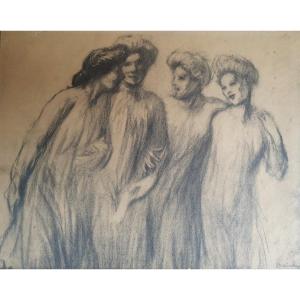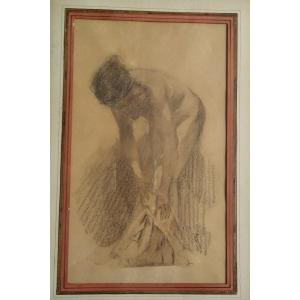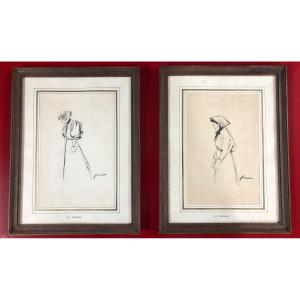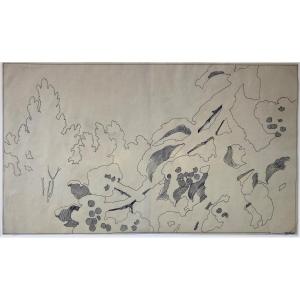- Margins more darkened, slight creases, minimally wavy.
- The contour of the Art Nouveau -
The female nude on the back is formed by a strongly curved Art Nouveau contour line, which allows the eye to glide along the body and makes the harmony of the female forms perceptible as ornamental movement. Hofmann creates the modulation of the inner body by blurring the red chalk as if it had been inhaled, so that the body, despite the strong contour, appears extremely delicate and exudes an aura of grace, while the expressive shadows cast further intensify the intensity of the effect emanating from the body. The head is posed in such a way that we cannot even guess at the profile. In this way, the figure is completely absorbed in the beauty of the living body.
"I was interested in the expressive, not the expressionistic. I feel humble towards nature, I don't want to rape it".
Ludwig von Hofmann
About the artist
Ludwig Hofmann studied at the Dresden Art Academy from 1883 to 1886 under Leonard Gey, Ferdinand Pauwels, Julius Scholtz, Friedrich Preller the Younger, and Léon Pohle, and was a master student of Ferdinand Keller at the Karlsruhe Art Academy from 1886 to 1888. Hofmann developed his own artistic ideas at an early age, which prompted Rainer Maria Rilke to have Hofmann illustrate his volume of poetry, "Lieder der Mädchen". In return, Rilke dedicated to Hofmann the cycle of poems "Die Bilder entlang", which was inspired by his works. The connection to literature is characteristic of Hofmann's oeuvre: Hugo von Hofmannthal, with whom Hofmann was friends, as well as Maurice Maeterlinck, Stefan George, and later especially Gerhard Hauptmann, wrote a foreword to the graphic portfolio "Tänze" (Dances), published in 1905. Hofmann later also worked as an illustrator, together with the book artist Marcus Behmer. For example, for Leopold Ziegler's translation of The Odyssey or Gerhart Hauptmann's Shepherd's Song.
In 1889, Hofmann was a student at the Académie Julian in Paris and was inspired by the works of Pierre Puvis de Chavannes and Paul-Albert Besnard. From 1890 Hofmann worked as a freelance artist in Berlin and was a member of the "Gruppe der Eleven" around Max Liebermann and Max Klinger, which later became the Secession. Hofmann designed the invitation card for the first exhibition of Künstlergruppe XI, the posters for the Free Berlin Art Exhibition in 1893, and the German Art Exhibition of the Berlin Secession in 1899. Hofmann also contributed works to the Secession exhibitions in Munich and Vienna. Since the founding of the Jugendstil magazine "Pan" in 1895, he regularly provided graphic contributions, as well as for "Jugend" and "Ver Sacrum".
Between 1894 and 1900, Hofmann spent a lot of time in Rome and at his villa near Fiesole, where he came to appreciate the painting of Hans von Marée, whose idea of a timeless, ancient Arcadia was to influence Hofmann's own work.
In 1903, Hofmann was appointed to the Grand Ducal Art School in Weimar, which was important for his artistic career. In 1905/06 Hofmann painted a six-part mural cycle for Henry van der Velde's museum hall at the Third German Arts and Crafts Exhibition in Dresden, and in 1907/08 the monumental frieze for the foyer of the Weimar Theater. In 1909 he created the monumental painting "Nine Muses" for the Senate Hall of the University of Weimar. In 1919 he designed the reading room of the German Library in Leipzig.
In Weimar, Hofmann was part of the "New Weimar" movement initiated by Harry Graf Kessler, which opposed Berlin's repressive art policies and would eventually become the Bauhaus. Through Kessler's international contacts, Hofmann became acquainted with Maurice Denis, Aristide Maillol, and Theo van Rysselberghe, who were pursuing related pictorial ideas. Among Hofmann's students in Weimar were Hans Arp and his son Gerhard Hauptmann Ivo. Hofmann had a long-standing friendship with Gerhart Hauptmann, which was accompanied by an intensive artistic exchange. In 1907 they traveled together to Greece, which Hofmann later described as the most important inspiration for his artistic development, along with the work of the painter Hans von Marées. In 1916 Hofmann succeeded Hermann Prell at the Dresden Art Academy, where he taught monumental painting until 1931.
In 1937, some of Hofmann's works were classified as "degenerate art" in Erfurt, but others continued to be exhibited in Germany. Hofmann died in Pillnitz in 1945. Ludwig von Hofmann's main estate is located in Potsdam, where the Ludwig von Hofmann Society is based.
Hofmann was honored with numerous awards: In 1896 he received the Gold Medal of the International Art Exhibition in Berlin, in 1897 the Gold Medal of the International Art Exhibition in Dresden, in 1906 the Certificate of Honor of the 3rd German Arts and Crafts Exhibition in Dresden, in 1908 the Knight's Cross of the 2nd Class of the Order of the White Falcon of Saxony-Weimar, In 1918 he was appointed Privy Councillor, in 1926 he received an honorary doctorate from the Faculty of Philosophy in Giessen, and in 1941 Hofmann was awarded the Goethe Medal for Art and Science.
Among the collectors of his works were the Austro-Hungarian Empress Elisabeth and the art historians Heinrich Wölfflin and Wilhelm von Bode. Thomas Mann incorporated impressions of Hofmann's work into his novel The Magic Mountain. The painting "Die Quelle", which he acquired in 1914, hung in Thomas Mann's study until his death.
In 2005, Ludwig von Hofmann, who was only gradually rediscovered, was the subject of a major monographic exhibition in his hometown of Darmstadt.
"Hofmann's work is characterized by his search for a neo-idealistic, neo-classical style that combines tradition and modernity, as well as his interest in the rhythmically moving figure.
Annette Wagner-Wilke
Portfolio Works
Dances (1905), Rhythms (1919), Rhythms, New Series (1921), Eros (1924).
Selected Works in Public Buildings
Frieze in the wedding room of the registry office at the Fischerbrücke in Berlin 1900, frieze in the foyer of the theater in Weimar 1907, murals in the senate hall of the University of Jena 1909, murals in the Werkbund Theater in Cologne 1914.
Selection of public collections that own works by Ludwig von Hofmann:
Alte Nationalgalerie Berlin, Hessisches Landesmuseum Darmstadt, Kunsthalle Hamburg, Kunsthalle Kiel, Kunsthaus Zürich, Kunstsammlung der Veste Coburg, Museum Leicestershire, Pushkin Museum Moscow, National Gallery Oslo, Neue Pinakothek Munich, Österreichische Galerie Belvedere Wien, Städtische Sammlung Dresden, Stiftung Moritzburg Halle.
Selected bibliography
Oskar Fischel: Ludwig von Hofmann, Bielefeld und Leipzig 1903.
Edwin Redslob (Hg.): Ludwig von Hofmann. Handzeichnungen, Weimar 1918.
Hand H. Hofstätter: Geschichte der europäischen+ Jugendstilmalerei, Köln 1963.
Herta Hesse-Frielinghaus (Hrsg.): Gerhart Hauptmann – Ludwig von Hofmann. Briefwechsel 1894–1944, Bonn 1983.
Contessa Roberts: Auf der Suche „nach dem entschwebten Land der Griechen“. Der Maler und Graphiker Ludwig von Hofmann (1861–1945). Ein Überblick über sein Œuvre mit besonderem Schwerpunkt auf Zeichnungen und Druckgraphik, Freiburg 2001.
Verena Senti-Schmidlin: Rhythmus und Tanz in der Malerei. Zur Bewegungsästhetik im Werk von Ferdinand Hodler und Ludwig von Hofmann. (= Studien zur Kunstgeschichte; Bd. 170), Hildesheim 2007.
Annette Wagner, Klaus Wolbert (Hrsg.): Ludwig von Hofmann (1861–1945). Arkadische Utopien in der Moderne, Darmstadt 2005.
Rolf Günther: Der Symbolismus in Sachsen 1870–1920, Dresden 2005.
Claus Bernet: Ludwig von Hofmanns „Träumerei“. Eine Berliner Bildgeschichte, Berlin 2011.
Städtische Sammlungen Freital, Schloss Burgk (Hrsg.): Ludwig von Hofmann: Sehnsucht nach dem Paradies, Dresden 2011.
Ingo Starz: "...die weiteste und herrlichste Weise, Schönheit zu gestalten". Ludwig von Hofmann, die Literaten und der Stildiskurs um 1900. In: Jugendstil und Kulturkritik, hrsg. von Andreas Beyer u. Dieter Burdorf, Heidelberg 1999, S. 156-176.

































 Le Magazine de PROANTIC
Le Magazine de PROANTIC TRÉSORS Magazine
TRÉSORS Magazine Rivista Artiquariato
Rivista Artiquariato